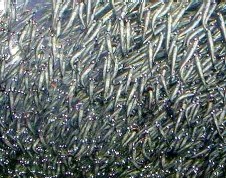|
The anchovies living near the Mediterranean coastline (up to 1 km) belong to a particular species (Egraulis albidus). They are white and smaller (10 to 12 cm). On the other hand those living deep down in the open sea (150m) which have a bluish sheen and measure 12 to 15 cm in length belong to another species (Engraulis encrasicolus).
Until now it was readily accepted that there were two populations of anchovy: one living in the open sea and the other in the briny waters of the estuaries from Brittany to Spain, the French Mediterranean coast, Sicily, Tunisia or in the North Sea (Netherlands) and in the Black Sea. These fish do not move very far unlike the others which hatch near the coast and when winter approaches they migrate to deeper water. They live in the North Sea (Great Britain, Ireland), in the Atlantic, in the Mediterranean (France, Italy, Algeria), in the Adriatic and in the Black Sea.
Genetic research by Philippe Borsa from the Institute for research and development has shown that these populations constitute different species. Although from their external appearance it is almost impossible to distinguish them apart except for the bluish sheen and the different habitats their chromosomes are different. It is possible that these two species were originally one and that they became different later on. Gourmets maintain that the quality of the flesh is very different. Jean-Luc Valet from Ifremer (French maritime research institute) explains that coastal anchovies have fattier flesh and that the lipids in their flesh retain aromas and enhance taste.
This discovery is important as it will enable better management of anchovy populations (there are several dozen species in the world with around 13 million tons caught). The great majority is transformed into meal for animal feed (mainly South American species). European anchovies are often consumed fresh or tinned. The coastal species is superior to the one in the open sea whose flesh decomposes quite quickly and which can only be eaten if it is stored in good conditions.
The anchovy weighs about thirty grams when it is adult. The females lay from 12.000 to 20.000 pelagic eggs. There are considerable losses of fry and young fish. The anchovy is prey to numerous marine and migratory fish. Living in shoals is its best protection against predators.
Top
|
